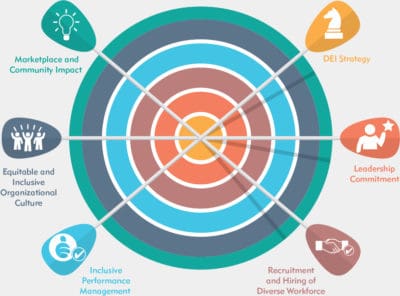The Evolution Of Target's Diversity, Equity, And Inclusion Strategy

Table of Contents
Early DEI Efforts at Target (Pre-2015): A Foundation for Change
Target's early DEI efforts, while less publicized than more recent initiatives, laid the groundwork for future progress. These initial steps primarily focused on supplier diversity, aiming to increase the number of minority-owned businesses in Target's supply chain. Internal diversity programs were also implemented, though details regarding these early initiatives remain scarce, suggesting a lack of public transparency concerning specific goals and measurable outcomes. While these early efforts are important to acknowledge, they lacked the comprehensive approach and public commitment that characterized later stages.
- Limited data on employee demographics and representation.
- Focus primarily on supplier diversity programs with less emphasis on internal representation.
- Absence of publicly stated, specific goals and measurable metrics for DEI.
Accelerated DEI Initiatives (2015-2020): Setting Ambitious Goals
The period between 2015 and 2020 marked a significant turning point in Target's DEI strategy. The company made a more public commitment to DEI, setting ambitious goals and targets across various dimensions of diversity. This included a broader focus beyond supplier diversity to encompass race, gender, LGBTQ+ inclusion, and disability representation within its workforce and leadership. Target began publishing diversity reports, though the specifics often lacked granular detail. This era saw the launch of several key initiatives:
- Expansion of employee resource groups (ERGs): Creating spaces for employees from various backgrounds to connect and support each other.
- Targeted recruitment strategies: Implementing programs focused on attracting and hiring diverse talent.
- Leadership development programs: Investing in training and development opportunities for employees from underrepresented groups.
- Supplier diversity expansion: Further strengthening commitments to inclusive sourcing.
Target's 2020 DEI progress report, while showcasing some progress, also highlighted the significant work still to be done.
Responding to Social Change and Heightened Expectations (2020-Present): Adapting and Evolving
The period from 2020 onwards has presented new challenges and opportunities for Target's DEI strategy. Increased social awareness and public demand for greater accountability from corporations on social justice issues have profoundly impacted Target's approach. The company's response to events such as the murder of George Floyd and the rise of the Black Lives Matter movement prompted further policy changes and shifts in its approach.
- Increased investment in community programs: Supporting organizations focused on racial justice and equity.
- Enhanced transparency and reporting: Publishing more detailed data and progress updates on DEI initiatives.
- Strengthened partnerships with diversity organizations: Collaborating with external groups to improve programs and strategies.
However, Target, like many other corporations, also faced criticism regarding its actions and the pace of change. The company’s responses to these criticisms have helped shape its current DEI strategy.
Measuring the Impact: Assessing Target’s Progress on DEI
Measuring the true impact of Target’s DEI initiatives presents a complex challenge. While Target publishes diversity data, comprehensive assessment requires evaluating not just representation but also inclusion, equity, and the overall impact on the employee experience. The availability of data varies across different dimensions of diversity.
- Challenges include accurately tracking the effectiveness of initiatives, addressing unconscious bias, and ensuring equitable opportunities for advancement.
- Independent studies and analyses of Target's DEI performance are needed to provide a more complete picture of its impact.
Conclusion
Target's DEI journey demonstrates a clear evolution from early, less transparent efforts to a more comprehensive and publicly committed strategy. While significant progress has been made, particularly in setting ambitious goals and expanding programs, challenges remain in fully achieving equitable representation and inclusion across all dimensions of diversity. Continued transparency, robust data collection, and ongoing adaptation are crucial for Target to achieve its long-term DEI goals. To learn more about Target’s current DEI initiatives and their ongoing commitment to creating a more diverse, equitable, and inclusive workplace, visit Target's corporate website and explore their dedicated DEI resources. Understanding Target's approach to diversity, equity, and inclusion offers valuable insights into the challenges and opportunities facing businesses striving for genuine social responsibility and improved Target diversity equity inclusion.

Featured Posts
-
 Minnesota Timberwolves Victory Edwards Impact On The Game Against Brooklyn Nets
May 01, 2025
Minnesota Timberwolves Victory Edwards Impact On The Game Against Brooklyn Nets
May 01, 2025 -
 Instagram And Whats App Under Fire The Ongoing Ftc V Meta Antitrust Case
May 01, 2025
Instagram And Whats App Under Fire The Ongoing Ftc V Meta Antitrust Case
May 01, 2025 -
 Saltillo Promueve La Transformacion Social A Traves Del Boxeo
May 01, 2025
Saltillo Promueve La Transformacion Social A Traves Del Boxeo
May 01, 2025 -
 Michael Sheens 100 K Donation A 1 Million Debt Relief Story
May 01, 2025
Michael Sheens 100 K Donation A 1 Million Debt Relief Story
May 01, 2025 -
 Fotos La Clase Nacional De Boxeo Llega Al Zocalo Capitalino
May 01, 2025
Fotos La Clase Nacional De Boxeo Llega Al Zocalo Capitalino
May 01, 2025
